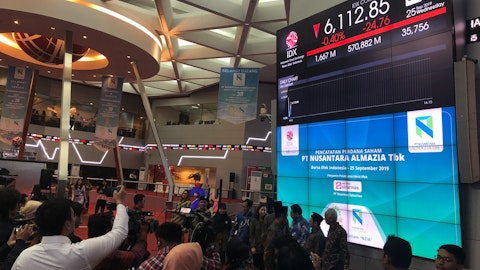DURECT Corporation (NASDAQ:DRRX) Q4 2023 Earnings Call Transcript March 27, 2024
DURECT Corporation beats earnings expectations. Reported EPS is $-0.27, expectations were $-0.36. DRRX isn’t one of the 30 most popular stocks among hedge funds at the end of the third quarter (see the details here).
Operator: Greetings and welcome to the DURECT Corporation Full Quarter and Full Year Earnings Conference Call. At this time, all participants are in a listen-only mode. A brief question-and-answer session will follow the formal presentation. [Operator Instructions] As a reminder, this conference is being recorded. It is now my pleasure to introduce your host, Tim Papp, Chief Financial Officer. Thank you, Tim. You may begin.
Tim Papp: Good afternoon and welcome to DURECT Corporation’s fourth quarter 2023 earnings conference call. This is Tim Papp, Chief Financial Officer, of DURECT. Before we begin, I would like to remind you of our safe harbor statement. During the course of this call, we may make forward-looking statements regarding DURECT’s products and development, expected product benefits, our development plans, future clinical trials, or projected financial results. These forward-looking statements involve risks and uncertainties that can cause actual results to differ materially from those in such forward-looking statements. Further information regarding these and other risks can be found in our SEC filings, including our 10-K and 10-Qs, under the heading Risk Factors.
To begin, I would like to review our fourth quarter and full year 2023 financial results. Total revenues in 2023 were $8.5 million compared to $19.3 million in 2022. 2023 revenues were lower primarily because 2022 revenues included $10 million of milestone payments related to our POSIMIR agreement with Innocoll. For the fourth quarter of 2023, revenues were $2.7 million compared to $3.3 million for the prior year. This decrease is due to lower revenue from collaborations in 2023. R&D expense was $29.4 million in 2023, as compared to $36.9 million for the prior year and $5.6 million for the fourth quarter, compared with $10 million for the prior year. The decreases were primarily due to lower clinical trial-related expenses as we substantially completed the AHFIRM trial, lower contract manufacturing expenses, and lower employee-related costs.
SG&A expenses were $14.4 million in 2023 as compared to $15.9 million for the prior year and $2.7 million for the fourth quarter compared with $4.3 million for the prior year. These decreases were primarily due to lower patent expenses as well as lower employee expenses. As of December 31, 2023, we had cash and investments of $29.8 million as compared to $43.6 million at December 31, 2022, and our cash burn for 2023 was $38.1 million, excluding net proceeds from financings. We believe our cash on hand is sufficient to fund operations through the end of 2024. Now I would like to turn the call over to Jim Brown, our Chief Executive Officer, for a business update.
Jim Brown: Thank you, Tim. Hello, everyone. Thank you for joining us today for our fourth quarter 2023 update. Last November, we announced top-line results from our AHFIRM Phase 2b clinical trial, which evaluated our larsucosterol and alcohol-associated hepatitis. The key takeaway from these results is that patients treated with larsucosterol had lower mortality at 90 days compared with patients that received placebo. We’re excited about the results and believe they show the potential for larsucosterol to provide a clinically meaningful survival benefit in these severe AH patients. To our knowledge, no previously controlled trial has demonstrated an improvement in mortality of this magnitude in this devastating disease. We also saw an encouraging safety profile for larsucosterol with a lower number of adverse events for the active arms as compared with placebo.

We are in ongoing communications with the FDA about the design for a potential confirmatory Phase 3 trial that could serve as the basis for an NDA filing. We expect to provide a further update in the second quarter. We continue to be encouraged by the overwhelming support of AH thought leaders and the broader hepatology community who have had no effective therapy for these patients. Our Phase 2b AHFIRM trial was a placebo-controlled, double-blind, multinational study with two active arms of 30 milligrams and 90 milligrams of larsucosterol and a placebo arm of approximately 100 patients each. We allowed physicians to utilize their standard practice for treating AH, which allowed for the use of corticosteroids in addition to supportive care, such as fluids and nutritional support, as well as antibiotics for infection.
In total, we randomized 307 patients with severe AH from a global network of clinical sites, including leading hospitals in the United States, Australia, the EU, and the UK. Our sites included renowned liver centers, and we had the honor of working with some of the world’s preeminent thought leaders in AH. The top-line results in the key secondary endpoint of mortality at 90 days showed a 41% reduction with a 30-milligram dose of larsucosterol and a 35% reduction with a 90-milligram dose of larsucosterol when compared with placebo. We also reported a numerical improvement in the primary endpoint of reduction in mortality or liver transplant at 90 days. So neither the primary or key secondary endpoint results achieved statistical significance.
Even more impressive results were observed in the US population, which comprised three-quarters of the total enrollment in a firm, that was 232 out of the 307 patients. In the US patients, we saw reductions in mortality of 57% and 58% for the 30-milligram and 90-milligram arms respectively, as compared with placebo. Although not part of the original statistical analysis plan, the p-values for these results were both approximately 0.01. Very importantly, larsucosterol exhibited an excellent safety profile with no serious adverse events in either arm and greater than 20% reductions in the number of treatment emergent adverse events for both active arms in the severely ill patients. Ultimately, these clinically meaningful reductions in mortality, coupled with the reduction in adverse events in these severely ill patients, reinforce the compelling risk-reward proposition for larsucosterol.
We are in active communication with the FDA about the design of a confirmatory Phase 3 trial in AH. We continue to believe that the AHFIRM data provide compelling evidence that larsucosterol could represent a safe and effective therapy with life-saving potential for AH patients. As a reminder, AH is the cause of more than 150,000 hospitalizations each year in the US. And with a 90-day mortality rate of approximately 30%, is responsible for tens of thousands of deaths each year. There are no effective treatments for AH. If larsucosterol meets our expectations in Phase 3 and we are able to gain approval, it would likely be the first FDA-approved treatment for this disease. In addition to its high mortality rate, AH represents a significant cost to the US healthcare system.
Hospitalizations attributed to AH typically incur costs ranging from $60,000 to over $160,000. This results in a total cost to hospitals of approximately $10 billion annually. As a result, larsucosterol represents a potential multi-billion dollar opportunity in the United States alone and could simultaneously provide overall cost savings to the healthcare system. We would now like to take any questions you may have.
See also 11 Best Beaten Down Dividend Stocks to Invest in Now and 25 Biggest Food Companies in the World by Revenue.
Q&A Session
Follow Durect Corp (NASDAQ:DRRX)
Follow Durect Corp (NASDAQ:DRRX)
Operator: Thank you. We will now be conducting a question-and-answer session. [Operator Instructions] Your first question comes from Francois Brisebois with Oppenheimer & Co. Please go ahead.
Francois Brisebois: Hi, can you help us understand maybe a little more the timing of when the discussions with the FDA took place, how long and maybe how long after that you intend on updating the market? Thank you.
Jim Brown: Hi, Frank. Right now we’re right in the middle of the communication, so I don’t have a sense. I mean I have some sense, but I really can’t share much from where we are now. I think we’ll have to wait for the process to complete. And then once we have clarity from them, then we will communicate that in a very back-end fashion.
Francois Brisebois: Understood. And then can you help us understand maybe a little bit of the feedback you’re getting from physicians from the, obviously the public cut of the data that you released?
Jim Brown: Yes, it’s been just extremely positive. As we all know, this disease hasn’t had really any major breakthrough as far as being able to help these patients out in more than 40 years. And in our US population, which was the 232 out of the 307, we had a 28% mortality, which fits right in with that 30% we’ve been talking about that’s been in the literature. With 150,000 hospitalizations, we’re talking 40-plus-thousand people dying every year in the United States. That’s about as many as die from breast cancer. And it’s a horrible circumstance. And there’s nothing out there. So when they see these data, and they see 40%, 50%, 60% reduction in mortality and what appears to be a safer alternative to what they’re giving today, certainly we’re not seeing anything in the way of increased side effects and potentially fewer.
That matters a lot to them. So we’ve got tremendous grassroots support from the physicians who treat these patients. And they are looking forward to getting the product out there and have — a great number of them have volunteered to help out. I guess I would let Norman — maybe, Norman, what are you hearing from your colleagues with regard to that?
Norman Sussman: Hello Frank. Yeah, it’s overwhelmingly positive. One of the — I think you were at the big meeting in Boston, and one of the leaders who wrote one of the very first overall papers on AH, when I showed it to him, said, man, this is the first positive result in over 30 years. It gives you some idea of the level of enthusiasm.
Francois Brisebois: Great, thank you. And then maybe can you share how involved with the FDA communications are thought leaders or just anything about that process or can you not disclose anything about that?
Jim Brown: Yeah, probably not. I mean, typically, the communication between the FDA is between the FDA and the company. But we do involve the thought leaders to a large extent as we’re looking at what the additional study would look like, the Phase 3 trial. So they’re involved heavily there. And we’re also having people involved, thought leaders involved in, as we analyze the data. Because this — I’ve heard a number of people say this is the most comprehensive study that’s probably been done in AH. We’re talking over 300 patients. We’re learning a lot about how this disease is diagnosed and treated globally as well as here in the United States. And so as every week or so goes by, we end up learning more from this database and more about this disease and how to approach the disease. So it’s really been just a wealth of information.
Francois Brisebois: Thank you.
Jim Brown: Sure, thank you.
Operator: The next question comes from Carl Byrnes with Northland Capital Markets. Please go ahead.
Carl Byrnes: Thanks for the question and congratulations on your progress here. I’m wondering — this is kind of on the heels of the prior questions, do you have any comments in terms of the FDA’s enthusiasm considering the urgent unmet medical need to treat AH and the compelling US subject subgroup analysis for larsucosterol along with the profound safety profile? And then I have a follow-up as well. Thanks.
Jim Brown: Yeah, I wouldn’t want to be trying to state what the FDA feel. I think they’re very clinical in their approach and very logical and rational. And so they’re — they certainly there are, I know, at least two physicians in this division that have treated liver patients. So I’m sure that this matters a lot to them, but I couldn’t speak to anything beyond that.
Carl Byrnes: Okay, fair enough. And then, do you have any comment on whether or not you continue to expect that the Phase 3 would be a US-only enrollment type study or has there been any change in terms of that thought process? Thanks.
Jim Brown: No, I don’t think so. I think we would still be looking to conduct it in the United States because of the homogeneity of healthcare provision in the United States. We’ve got a large population here, a huge problem here. And the disease is, although it certainly is a global disease and it influences people, unfortunately, everywhere around the world where alcohol is consumed. And — but in the United States, we do have our population. I think we’ve talked about this. Generally speaking, they were a bit younger than the outside regions of the world. Also, we tend to have a number of metabolic issues from the diets that we have. When you combine that with alcohol, you end up with patients that I think are maybe a bit more predisposed to this disease. But that being said, I do believe once this drug has a chance to be tested again, there’ll be a nice opportunity for it both inside the US and outside the US because this disease is a global problem.



